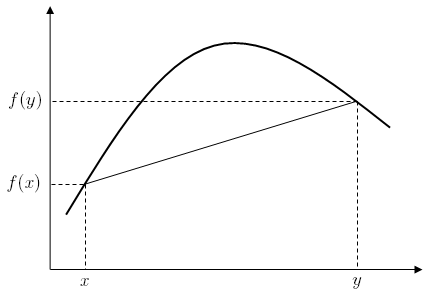Continuous Strictly Concave Utility Function Unique Solution
In mathematics, a concave function is the negative of a convex function. A concave function is also synonymously called concave downwards, concave down, convex upwards, convex cap, or upper convex.
Definition [edit]
A real-valued function on an interval (or, more generally, a convex set in vector space) is said to be concave if, for any and in the interval and for any ,[1]
A function is called strictly concave if
for any and .
For a function , this second definition merely states that for every strictly between and , the point on the graph of is above the straight line joining the points and .

A function is quasiconcave if the upper contour sets of the function are convex sets.[2]
Properties [edit]
Functions of a single variable [edit]
- A differentiable function f is (strictly) concave on an interval if and only if its derivative function f ′ is (strictly) monotonically decreasing on that interval, that is, a concave function has a non-increasing (decreasing) slope.[3] [4]
- Points where concavity changes (between concave and convex) are inflection points.[5]
- If f is twice-differentiable, then f is concave if and only if f ′′ is non-positive (or, informally, if the "acceleration" is non-positive). If its second derivative is negative then it is strictly concave, but the converse is not true, as shown by f(x) = −x 4 .
- If f is concave and differentiable, then it is bounded above by its first-order Taylor approximation:[2]
- A Lebesgue measurable function on an interval C is concave if and only if it is midpoint concave, that is, for any x and y in C
- If a function f is concave, and f(0) ≥ 0, then f is subadditive on . Proof:
- Since f is concave and 1 ≥ t ≥ 0, letting y = 0 we have
- For :
- Since f is concave and 1 ≥ t ≥ 0, letting y = 0 we have
Functions of n variables [edit]
- A function f is concave over a convex set if and only if the function −f is a convex function over the set.
- The sum of two concave functions is itself concave and so is the pointwise minimum of two concave functions, i.e. the set of concave functions on a given domain form a semifield.
- Near a local maximum in the interior of the domain of a function, the function must be concave; as a partial converse, if the derivative of a strictly concave function is zero at some point, then that point is a local maximum.
- Any local maximum of a concave function is also a global maximum. A strictly concave function will have at most one global maximum.
Examples [edit]
Applications [edit]
- Rays bending in the computation of radiowave attenuation in the atmosphere involve concave functions.
- In expected utility theory for choice under uncertainty, cardinal utility functions of risk averse decision makers are concave.
- In microeconomic theory, production functions are usually assumed to be concave over some or all of their domains, resulting in diminishing returns to input factors.[7]
See also [edit]
- Concave polygon
- Jensen's inequality
- Logarithmically concave function
- Quasiconcave function
- Concavification
References [edit]
- ^ Lenhart, S.; Workman, J. T. (2007). Optimal Control Applied to Biological Models. Mathematical and Computational Biology Series. Chapman & Hall/ CRC. ISBN978-1-58488-640-2.
- ^ a b Varian, Hal R. (1992). Microeconomic analysis (3rd ed.). New York: Norton. p. 489. ISBN0-393-95735-7. OCLC 24847759.
- ^ Rudin, Walter (1976). Analysis. p. 101.
- ^ Gradshteyn, I. S.; Ryzhik, I. M.; Hays, D. F. (1976-07-01). "Table of Integrals, Series, and Products". Journal of Lubrication Technology. 98 (3): 479. doi:10.1115/1.3452897. ISSN 0022-2305.
- ^ Hass, Joel (13 March 2017). Thomas' calculus. Heil, Christopher, 1960-, Weir, Maurice D.,, Thomas, George B., Jr. (George Brinton), 1914-2006. (Fourteenth ed.). [United States]. p. 203. ISBN978-0-13-443898-6. OCLC 965446428.
- ^ Cover, Thomas M.; Thomas, J. A. (1988). "Determinant inequalities via information theory". SIAM Journal on Matrix Analysis and Applications. 9 (3): 384–392. doi:10.1137/0609033. S2CID 5491763.
- ^ Pemberton, Malcolm; Rau, Nicholas (2015). Mathematics for Economists: An Introductory Textbook. Oxford University Press. pp. 363–364. ISBN978-1-78499-148-7.
Further References [edit]
- Crouzeix, J.-P. (2008). "Quasi-concavity". In Durlauf, Steven N.; Blume, Lawrence E (eds.). The New Palgrave Dictionary of Economics (Second ed.). Palgrave Macmillan. pp. 815–816. doi:10.1057/9780230226203.1375. ISBN978-0-333-78676-5.
- Rao, Singiresu S. (2009). Engineering Optimization: Theory and Practice. John Wiley and Sons. p. 779. ISBN978-0-470-18352-6.
Source: https://en.wikipedia.org/wiki/Concave_function



![\alpha \in [0,1]](https://wikimedia.org/api/rest_v1/media/math/render/svg/daf3c62599ea71319c85f715c9e590d2bab2d036)










![{\displaystyle f(y)\leq f(x)+f'(x)[y-x]}](https://wikimedia.org/api/rest_v1/media/math/render/svg/ad4b94b94e56ebbdad4a9badaa4412142b032c08)





0 Response to "Continuous Strictly Concave Utility Function Unique Solution"
Post a Comment